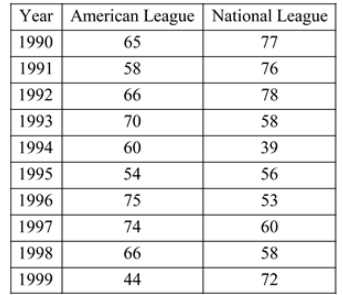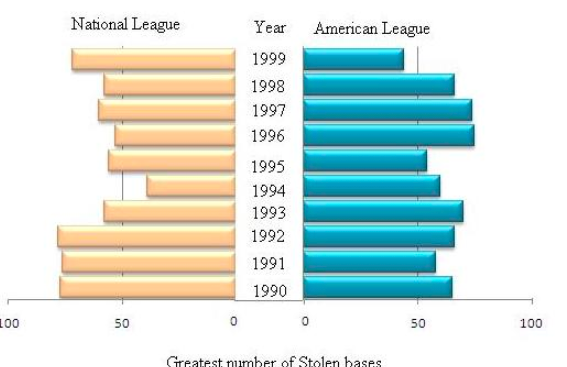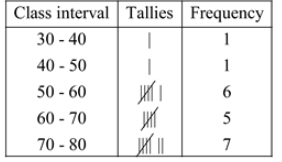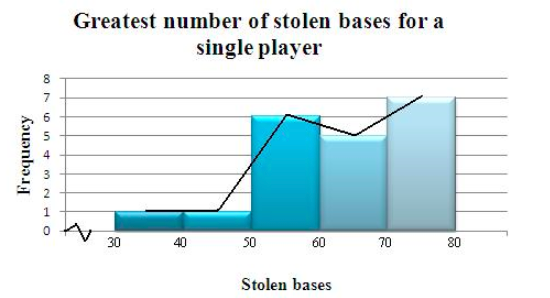
Concept explainers
To make a back-to-back bar graph for the given data.
Explanation of Solution
Given:
The table which gives the greatest numbers of stolen bases for a single player

Calculation:
Let the central axis be labeled by year. Draw a horizontal axis that is scaled 0 to 100 in each direction. Let the left side of the graph represent the National league and the right side of the graph represents American League
Draw the bars to the appropriate length for the data.
The back-to-back bar graph for the above data is

To combine the data from both leagues to construct a frequency distribution.
Answer to Problem 13E
Explanation of Solution
Given:
The table gives the greatest numbers of stolen bases for a single player.
Calculation:
Since the data ranges from
Make a table listing class limits; Use the tallies to determine the number of scores in each interval

To draw the histogram of data and frequency
Explanation of Solution
Given:
The table gives the greatest numbers of stolen bases for a single player.
Calculation:
Label the horizontal axis with the class limits. The vertical axis should be labeled from 0 to a value that will allow for the bars side by side so that the height of the bar corresponds to its interval’s frequency
The histogram of the above data is as below and then joining the class marks of each class to get the frequency polygon as below

To find the number of players made
Answer to Problem 13E
Explanation of Solution
Given:
The table gives the greatest numbers of stolen bases for a single player.
Calculation:
By studying the frequency distribution table we conclude that
To find the number of players that made less than
Answer to Problem 13E
Explanation of Solution
Given:
The table gives the greatest numbers of stolen bases for a single player.
Calculation:
Only
Chapter 14 Solutions
Advanced Mathematical Concepts: Precalculus with Applications, Student Edition
Additional Math Textbook Solutions
A Problem Solving Approach To Mathematics For Elementary School Teachers (13th Edition)
University Calculus: Early Transcendentals (4th Edition)
Intro Stats, Books a la Carte Edition (5th Edition)
Algebra and Trigonometry (6th Edition)
Pre-Algebra Student Edition
 Calculus: Early TranscendentalsCalculusISBN:9781285741550Author:James StewartPublisher:Cengage Learning
Calculus: Early TranscendentalsCalculusISBN:9781285741550Author:James StewartPublisher:Cengage Learning Thomas' Calculus (14th Edition)CalculusISBN:9780134438986Author:Joel R. Hass, Christopher E. Heil, Maurice D. WeirPublisher:PEARSON
Thomas' Calculus (14th Edition)CalculusISBN:9780134438986Author:Joel R. Hass, Christopher E. Heil, Maurice D. WeirPublisher:PEARSON Calculus: Early Transcendentals (3rd Edition)CalculusISBN:9780134763644Author:William L. Briggs, Lyle Cochran, Bernard Gillett, Eric SchulzPublisher:PEARSON
Calculus: Early Transcendentals (3rd Edition)CalculusISBN:9780134763644Author:William L. Briggs, Lyle Cochran, Bernard Gillett, Eric SchulzPublisher:PEARSON Calculus: Early TranscendentalsCalculusISBN:9781319050740Author:Jon Rogawski, Colin Adams, Robert FranzosaPublisher:W. H. Freeman
Calculus: Early TranscendentalsCalculusISBN:9781319050740Author:Jon Rogawski, Colin Adams, Robert FranzosaPublisher:W. H. Freeman
 Calculus: Early Transcendental FunctionsCalculusISBN:9781337552516Author:Ron Larson, Bruce H. EdwardsPublisher:Cengage Learning
Calculus: Early Transcendental FunctionsCalculusISBN:9781337552516Author:Ron Larson, Bruce H. EdwardsPublisher:Cengage Learning





